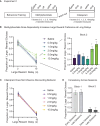Methylphenidate, but not citalopram, decreases impulsive choice in rats performing a temporal discounting task
- PMID: 38779546
- PMCID: PMC11109432
- DOI: 10.3389/fpsyt.2024.1385502
Methylphenidate, but not citalopram, decreases impulsive choice in rats performing a temporal discounting task
Abstract
Introduction: Drugs targeting monoamine systems remain the most common treatment for disorders with impulse control impairments. There is a body of literature suggesting that drugs affecting serotonin reuptake and dopamine reuptake can modulate distinct aspects of impulsivity - though such tests are often performed using distinct behavioral tasks prohibiting easy comparisons.
Methods: Here, we directly compare pharmacologic agents that affect dopamine (methylphenidate) vs serotonin (citalopram) manipulations on choice impulsivity in a temporal discounting task where rats could choose between a small, immediate reward or a large reward delayed at either 2 or 10s. In control conditions, rats preferred the large reward at a small (2s) delay and discounted the large reward at a long (10s) delay.
Results: Methylphenidate, a dopamine transport inhibitor that blocks reuptake of dopamine, dose-dependently increased large reward preference in the long delay (10s) block. Citalopram, a selective serotonin reuptake inhibitor, had no effect on temporal discounting behavior. Impulsive behavior on the temporal discounting task was at least partially mediated by the nucleus accumbens shell. Bilateral lesions to the nucleus accumbens shell reduced choice impulsivity during the long delay (10s) block. Following lesions, methylphenidate did not impact impulsivity.
Discussion: Our results suggest that striatal dopaminergic systems modulate choice impulsivity via actions within the nucleus accumbens shell, whereas serotonin systems may regulate different aspects of behavioral inhibition/impulsivity.
Keywords: citalopram; impulsivity; methylphenidate; nucleus accumbens; temporal discounting.
Copyright © 2024 Koloski, Terry, Lee and Ramanathan.
Conflict of interest statement
The authors declare that the research was conducted in the absence of any commercial or financial relationships that could be constructed as a potential conflict of interest.
Figures



Similar articles
-
Decision making: effects of methylphenidate on temporal discounting in nonhuman primates.J Neurophysiol. 2015 Jul;114(1):70-9. doi: 10.1152/jn.00278.2015. Epub 2015 May 13. J Neurophysiol. 2015. PMID: 25972584 Free PMC article.
-
Ventral Striatal D2/3 Receptor Availability Is Associated with Impulsive Choice Behavior As Well As Limbic Corticostriatal Connectivity.Int J Neuropsychopharmacol. 2018 Jul 1;21(7):705-715. doi: 10.1093/ijnp/pyy030. Int J Neuropsychopharmacol. 2018. PMID: 29554302 Free PMC article.
-
Tyrosine Hydroxylase-positive Nucleus Accumbens Neurons Influence Delay Discounting in a Mouse T-maze Task.eNeuro. 2024 Dec 3:ENEURO.0487-24.2024. doi: 10.1523/ENEURO.0487-24.2024. Online ahead of print. eNeuro. 2024. PMID: 39626950
-
Impulsive Rats Exhibit Blunted Dopamine Release Dynamics during a Delay Discounting Task Independent of Cocaine History.eNeuro. 2017 Apr 24;4(2):ENEURO.0119-17.2017. doi: 10.1523/ENEURO.0119-17.2017. eCollection 2017 Mar-Apr. eNeuro. 2017. PMID: 28451642 Free PMC article.
-
A Role for Serotonin in Modulating Opposing Drive and Brake Circuits of Impulsivity.Front Behav Neurosci. 2022 Feb 17;16:791749. doi: 10.3389/fnbeh.2022.791749. eCollection 2022. Front Behav Neurosci. 2022. PMID: 35250501 Free PMC article. Review.
References
Grants and funding
LinkOut - more resources
Full Text Sources

